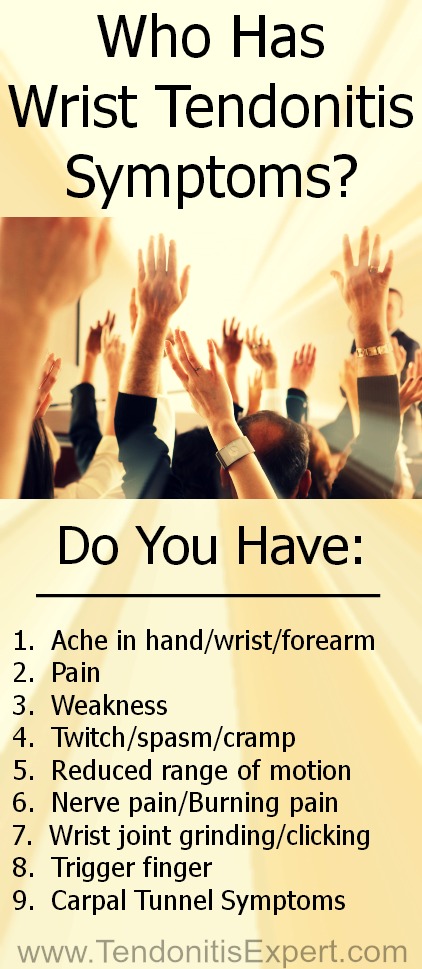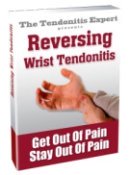Wrist Tendonitis Symptoms
Different Reasons For Each One
Wrist Tendonitis Symptoms range from mild to severe.
Like all repetitive strain injuries having Tendonitis in the Wrist can be a serious issue.
You're still doing whatever it is that got you into a situation of pain, and unless you change your activity entirely....
Even if you only have mild complaint (caused by something like repetitive strain), don't doubt for a minute that it is going to get worse sooner or later if you continue doing what you do.
Wrist Tendons, controlled by muscles in the forearm, work together to pull your wrist/hand up, down, side to side, in a circular motion, and to various angles. They also stabilize the wrist while the fingers work.
The tendon is one of the places where actual damage from repetitive strain injury takes place (when there is any actual damage done).
But DO NOT just focus on the tendon. It's the ENTIRE structure that is involved. The tendon pain is a SYMPTOM, not a cause of a problem.
When you overuse your muscles, you overuse your tendons and your muscles. This can kick in a process of Inflammation.
Some people may call it Hand Tendonitis Symptoms, or even google search for ' tendonitis hand symptoms ' because they feel symptoms in their hands, but although the pain might be in the hands, even the wrists, that's not where the actual problem is.
There are many possible symptoms. Each one shows up for specific reasons.
Wrist Tendonitis Symptoms
Cause And Effect
Forearm and/or Wrist Pain
Pain in the forearm and wrist is the main Wrist Tendonitis Symptom.
Be aware that if you're looking for a Wrist Pain Diagnosis, tendonitis isn't the only option. Other possibilities are
- Tendonitis
- Tenosynovitis
- Ganglion Cyst
- Lipoma
- nutritional deficiency
- Bone Spur
- etc.
This page is specifically about Wrist Tendonitis Symptoms.
Pain in the forearm and pain in the wrist can show up differently for different people. It can be burning, aching, sharp or dull, constant or recurring.
The onset of pain usually happens slowly over time, comes and goes, and gets worse as you continue to do the same activities that made it start hurting in the first place.
Then it gets so bad that you realize that you have a problem that isn't going to go away.
If you press your fingers or thumb into the muscles in your forearm, you will likely find them to be -very- tender. This my be surprising if you have only been feeling pain in your wrist.
If you have pain in your wrist, you definitely also have something going on in the forearm muscles that control the tendons of the wrist.
Decreased Range of Motion
Muscles and connective tissue get tight from working, and then to 'protect' you from pain. This causes some degree of tenderness or pain in the body.
In an attempt to protect your from pain, muscle and connective tissue get tight.
This can constrict the mobility of your wrist, fingers, and even your elbow joint.
Imagine wrapping your wrist tightly in saran wrap. Then imagine trying to move it around.
Essentially, the same thing is happening as your tissue shrink- wraps itself down around your bones.
The tighter you are, the harder you have to work, and the less able you are to work.
Sharp and/or Shooting Pain
Shooting pain is the most extreme of Wrist Tendinitis Symptoms.
At least, it shows up as the Pain Causing Dynamic gets worse and worse.
For various reasons including Repetitive Strain Injury and/or one time overuse injuries, all the muscles and structure connected to your wrist (hand, forearm, shoulder, neck) become too tight. Then you start to feel pain.
After a certain amount of time of being too tight and hurting, the body becomes hyper-reactive, or said another way, overprotective.
This means your body gets into more and more of a defensive, protective mode.
The shooting pain is from short, INTENSE spasms of already severely tight, painful, unhappy muscles as the nervous system overreacts to a movement it perceives as a threat.
Consider that your body is trying to keep you safe from future harm. Ironically, the way it does that is by causing you pain.
Essentially, your body is trying to keep you from moving, in the hopes that you stop causing yourself more pain. Again, the irony, it uses more pain to do that.
Unfortunately, there's more to the story.
Rest may help reduce the pain, but it does not change the dynamic of pain and tightness that has become your body's new habit. So if you start doing the actions that cause you pain after a period of rest, pain almost always returns.
Loss of Hand Strength
This can be a very distressing Wrist Tendonitis symptom.
Tendonitis of wrist causes your forearm muscles to become chronically tight.
As the nerve that feeds the arm, hand, and fingers gets more and more compressed by tight muscles, the nerve is less able to operate at full capacity. Kind of like stepping on a hose, it slows or stops the flow of water.
You may be experiencing a barely noticeable decrease, or a severe loss of strength.
This is likely not a true 'loss of strength', as compared to strength loss from a Carpal Tunnel Syndrome situation.
It is most likely just a perceived loss of strength. In reality, your muscles are now so tight and your nervous system so concerned about you hurting yourself more, that activation of the muscles to pick something up causes so much pain (even if you can't consciously feel it) that your system will stop the work required, feeling like less strength.
Said another way, if you do something that causes, or is about to cause yourself a certain level of pain, your body will refuse.
This can also look like an actual jolt of pain if you 'do something wrong' with your hand/wrist.
Wrist Tendonitis Symptoms are caused by an entire dynamic of actual damage on the tendon, muscle tightness, tissue shortening, and pain that results from all that.
Ignoring Tendonitis of the Wrist almost certainly results in an eventual acquisition of more severe symptoms.
Knuckle Pain
A symptom of knuckle pain is very possibly caused by the wrist tendonitis dynamic.
Muscles in the forearm turn in to tendons that cross the wrist and knuckle joint(s).
Those muscles get tight, and constantly pull on the tendons, and that compresses the finger, knuckle, and wrist joints.
This constant compression irritates and then damages the inner joint lining.
This of course can cause Knuckle Pain.
Numbness
Numbness can be a Wrist Tendonitis Symptom.
Is it because of nerve damage?
Not likely.
Is it because of a compressed median nerve? Maybe.
Is that a problem? Not if you know how to deal with it.
If your forearm muscles are tight, and connective tissue is all shrunk down like saran wrap stretched tight around your arm, the nerve the feeds the hand can be getting compressed. (This is also happening at the neck and front of shoulder and chest.)
Kind of like stepping on a hose, but more like lots of little feet stepping on it.
There's more to learn, so get the free E-Course below.
Constant Or Recurring Symptoms
Symptoms of Wrist Tendonitis can be constant or recurring.
If you have Recurring Wrist Tendonitis then your body is constantly compensating for all the pain and tightness that is happening.
And winning.....for a while until the pain comes back.
Eventually, recurring Wrist Tendonitis symptoms become constant as the body can no longer successfully compensate for the downward spiral of the worsening Pain Causing Dynamic.
Nutrition As A Factor In Wrist Tendonitis Symptoms
Your body needs nutritional building blocks to work properly/optimally.
Magnesium
If you don't have enough Magnesium, then muscles literally can't relax and are stuck in contraction (thus, they stay tight even when you're sleeping).
Vitamin B6
While it's usually more of a factor in Carpal Tunnel Symptoms, lack of Vitamin B6 can and does cause pain/problem. And Inflammation Causes Vitamin B6 Deficiency, so again it's part of that Downward Spiral of more problem --> more pain --> more problem --> more pain --> repeat.
And depending on what you have going on, there are many other possible factors, like:
- do you have actual rip/tear injury or not?
- are you chronically dehydrated
- are you getting adequate sleep so your cortisol cycle is doing what it should be doing and you're 'healing' at night
- adequate protein and fat intake?
- etc....
What to do about Wrist Tendonitis Symptoms
The How To Reduce Inflammation page has information you need that will help you get out of pain, loosen up tight muscles, and begin to reverse your Wrist Tendonitis Symptoms.
That's a great place to start and it may be everything that you need to keep the pain away.
You can also sign up for a phone consultation and we can make sure that you are on the right track -and- give you whatever information you need to eliminate your wrist tendinitis.
And if you're serious about getting out of pain, you should get my program and learn exactly how to Reverse Wrist Tendonitis.
Go back to the top of this Wrist Tendonitis Symptoms page.
Go to the Wrist Tendonitis page.
Go to the main Tendonitis page.
Go to the TendonitisExpert.com homepage.
| Share Your Story
|




